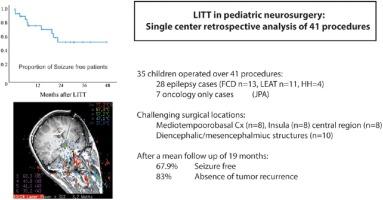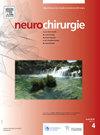激光间质热疗法(LITT)在小儿神经外科中的应用:41例连续手术的单中心回顾性分析。
IF 1.4
4区 医学
Q4 CLINICAL NEUROLOGY
引用次数: 0
摘要
简介:MRI控制下的激光间质热疗法已经成为癫痫和神经肿瘤手术中安全有效的替代方法。然而,它只是最近才在少数几个欧洲中心使用。在此,我们报告了我们在儿童LITT治疗中4年的经验(并发症、癫痫和肿瘤预后)。方法:对2021-2024年期间连续LITT手术的单中心回顾性研究。在以下适应症中,LITT仅限于儿科:(i)限定病变(ii)良性病理(iii)显微手术切除位置有问题。机器人立体定向植入后,在MRI引导下使用VISUALASE系统进行消融。术后1个月、3个月、6个月和12个月进行系统门诊和MRI检查。癫痫预后在ILAE分类后定义,肿瘤复发定义为随访1个月后体积增加。结果:35例患儿,平均年龄11.4岁,M/F比值= 0.8,共41次手术。主要指征为局灶性癫痫28例,FCD 13例,LEAT 11例,HH 4例,肿瘤治疗7例。脑岛皮质区(n = 8)、中颞基底区(n = 8)和中央旁区(n = 6)或皮质下区(下丘脑和基底节区n = 6,中脑n = 4)出现病变。围手术期短暂性不良事件发生率为25.7%,2例患儿出现持续性神经功能缺损。平均随访31.2个月,67.9%的患者无癫痫发作,3/18例出现肿瘤复发。结论:在35例具有挑战性脑病变的儿童队列中,LITT消融是安全有效的。本文章由计算机程序翻译,如有差异,请以英文原文为准。

Laser Interstitial Thermal Therapy (LITT) in pediatric neurosurgery: Single center retrospective analysis of 41 consecutive procedures
Introduction
Laser Interstitial Thermal Therapy under MRI control has emerged as a safe and efficient alternative to microsurgery in epilepsy and neurooncology procedures. Yet it has been used only recently in seldom European centers. Here, we report our 4 years’ experience with LITT in children (complications, epileptic and oncologic outcomes).
Methods
Single center retrospective study of consecutive LITT procedures during the 2021–2024 period. LITT was restricted to pediatrics in the following indications: (i) circumscribed lesion (ii) benign pathology (iii) problematic location for microsurgical resection. After a robotic stereotactic implantation, ablation was performed under MRI guidance with the VISUALASE system. Post operative outpatient clinic and MRI were systematic at 1, 3, 6 and 12 months. Epileptic outcome was defined after ILAE classification, oncological relapse was defined as a volumetric increase after 1 month of follow up.
Results
35 children (mean age 11.4yo, M/F ratio = 0.8) were operated in 41 successive procedures. Main indication was focal epilepsy (n = 28 patients; FCD n = 13, LEAT n = 11, HH n = 4) while 7 children were treated for oncological purposes. Lesions were cortical in the insula (n = 8), mediotemporobasal (n = 8) and paracentral (n = 6) regions or subcortical (hypothalamus and basal ganglia n = 6, mesencephalon n = 4). Perioperative transient adverse events occurred in 25.7% and persistent neurological deficit was noted in 2 children. After a mean follow up of 31.2 months, 67.9% of the patients are seizure free and tumoral recurrence was observed in 3/18 cases.
Conclusion
In this pediatric cohort of 35 children with challenging brain lesions, LITT ablation was safe and efficient.
求助全文
通过发布文献求助,成功后即可免费获取论文全文。
去求助
来源期刊

Neurochirurgie
医学-临床神经学
CiteScore
2.70
自引率
6.20%
发文量
100
审稿时长
29 days
期刊介绍:
Neurochirurgie publishes articles on treatment, teaching and research, neurosurgery training and the professional aspects of our discipline, and also the history and progress of neurosurgery. It focuses on pathologies of the head, spine and central and peripheral nervous systems and their vascularization. All aspects of the specialty are dealt with: trauma, tumor, degenerative disease, infection, vascular pathology, and radiosurgery, and pediatrics. Transversal studies are also welcome: neuroanatomy, neurophysiology, neurology, neuropediatrics, psychiatry, neuropsychology, physical medicine and neurologic rehabilitation, neuro-anesthesia, neurologic intensive care, neuroradiology, functional exploration, neuropathology, neuro-ophthalmology, otoneurology, maxillofacial surgery, neuro-endocrinology and spine surgery. Technical and methodological aspects are also taken onboard: diagnostic and therapeutic techniques, methods for assessing results, epidemiology, surgical, interventional and radiological techniques, simulations and pathophysiological hypotheses, and educational tools. The editorial board may refuse submissions that fail to meet the journal''s aims and scope; such studies will not be peer-reviewed, and the editor in chief will promptly inform the corresponding author, so as not to delay submission to a more suitable journal.
With a view to attracting an international audience of both readers and writers, Neurochirurgie especially welcomes articles in English, and gives priority to original studies. Other kinds of article - reviews, case reports, technical notes and meta-analyses - are equally published.
Every year, a special edition is dedicated to the topic selected by the French Society of Neurosurgery for its annual report.
 求助内容:
求助内容: 应助结果提醒方式:
应助结果提醒方式:


